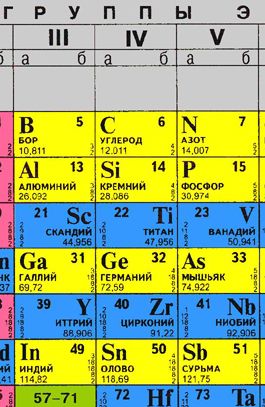Categories: Interesting Facts, Novice electricians
Number of views: 216769
Comments on the article: 3
Transistors: purpose, device and principles of operation
See the first part of the article here: Transistor history.
What does the name "transistor" mean
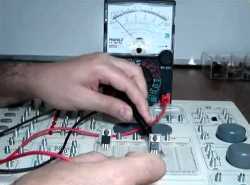 The transistor did not immediately receive such a familiar name. Initially, by analogy with the lamp technique, it was called semiconductor triode. The modern name consists of two words. The first word is “transfer” (here, I immediately recall “transformer”) means a transmitter, converter, and carrier. And the second half of the word resembles the word "resistor" - a detail of electrical circuits, the main property of which is electrical resistance.
The transistor did not immediately receive such a familiar name. Initially, by analogy with the lamp technique, it was called semiconductor triode. The modern name consists of two words. The first word is “transfer” (here, I immediately recall “transformer”) means a transmitter, converter, and carrier. And the second half of the word resembles the word "resistor" - a detail of electrical circuits, the main property of which is electrical resistance.
It is this resistance that occurs in Ohm's law and many other formulas of electrical engineering. Therefore, the word "transistor" can be interpreted as a resistance converter. About the same as in hydraulics, the change in fluid flow is controlled by a valve. For a transistor, such a “valve” changes the amount of electric charges that create an electric current. This change is nothing more than a change in the internal resistance of a semiconductor device.
Amplification of electrical signals
The most common operation that is performed transistors, is an amplification of electrical signals. But this is not quite the right expression, because the weak signal from the microphone remains so.
Amplification is also required in radio and television: a weak signal from a billionth watt antenna must be amplified to such an extent that a sound or image appears on the screen. And this is a power of several tens, and in some cases hundreds of watts. Therefore, the amplification process is reduced to ensure that with the help of additional sources of energy received from the power supply, to obtain a powerful copy of a weak input signal. In other words, a low-power input stimulates powerful energy flows.
Amplification in other areas of technology and nature
Such examples can be found not only in electrical circuits. For example, when you press the gas pedal, the speed of the car increases. At the same time, you do not have to press the gas pedal very hard - in comparison with the engine power, the pressure on the pedal is negligible. To reduce the speed, the pedal will have to be released somewhat, to weaken the input effect. In this situation, gasoline is a powerful source of energy.
The same effect can be observed in hydraulics: very little is spent on opening an electromagnetic valve, for example in a machine tool. And the oil pressure on the piston of the mechanism can create a force of several tons. This force can be adjusted if an adjustable valve is provided in the oil pipe, as in a conventional kitchen faucet. Slightly covered up - the pressure dropped, the pressure dropped. If you opened more, then the pressure intensified.
It is also not necessary to make special efforts to turn the valve. In this case, the pumping station of the machine is an external source of energy. And there are a great many similar influences in nature and technology. But still, we are more interested in the transistor, so we will have to consider further ...
Signal amplifiers
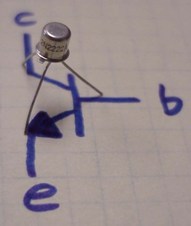 In most amplifying circuits, transistors or electronic tubes are used as a variable resistor, the resistance of which changes under the influence of a weak input signal. This "variable resistor" is an integral part of the DC circuit, which receives power, for example, from galvanic cells or batteries, so a constant current begins to flow in the circuit. The initial value of this current (there is no input signal yet) is set when setting up the circuit.
In most amplifying circuits, transistors or electronic tubes are used as a variable resistor, the resistance of which changes under the influence of a weak input signal. This "variable resistor" is an integral part of the DC circuit, which receives power, for example, from galvanic cells or batteries, so a constant current begins to flow in the circuit. The initial value of this current (there is no input signal yet) is set when setting up the circuit.
Under the influence of the input signal, the internal resistance of the active element (transistor or lamp) changes in time with the input signal. Therefore, direct current turns into alternating current, creating a powerful copy of the input signal at the load. How accurate this copy will be depends on many conditions, but we will talk about this later.
The action of the input signal is very similar to the gas pedal mentioned above or the valve in the hydraulic system. To understand what is such a gate valve in a transistor, you have to tell, at least very simplified, but true and understandable about some processes in semiconductors.
Conductivity and atomic structure
An electric current is created due to the movement of electrons in the conductor. In order to understand how this happens, you will have to consider the structure of the atom. The consideration, of course, will be as simplified as possible, even primitive, but allowing you to understand the essence of the process, no more than is necessary to describe the operation of semiconductors.
In 1913, the Danish physicist Niels Bohr proposed a planetary model of the atom, which is shown in Figure 1.

Figure 1. Planetary atom model
According to his theory, an atom consists of a nucleus, which, in turn, consists of protons and neutrons. Protons are carriers of a positive electric charge, and neutrons are electrically neutral.
Around the nucleus, electrons rotate in orbits whose negative electric charge is. The number of protons and electrons in an atom is the same, and the electric charge of the nucleus is balanced by the total charge of electrons. In this case, they say that the atom is in a state of equilibrium or is electrically neutral, that is, it does not carry a positive or negative charge.
If an atom loses an electron, then its electric charge becomes positive, and the atom itself in this case becomes a positive ion. If an atom attaches to itself a foreign electron, then it is called a negative ion.
Figure 2 shows a fragment of the periodic table. Let's pay attention to the rectangle in which silicon (Si) is located.
Figure 2. Fragment of the periodic table
In the lower right corner is a column of numbers. They show how the electrons are distributed over the orbits of the atom - the bottom digit closest to the core of the orbit. If you look closely at Figure 1, we can say with confidence that we have a silicon atom with an electron distribution of 2, 8, 4. Figure 1 is voluminous, it almost shows that the orbits of the electrons are spherical, but for further reasoning, we can assume that they are in the same plane, and all electrons run along the same track, as shown in Figure 3.
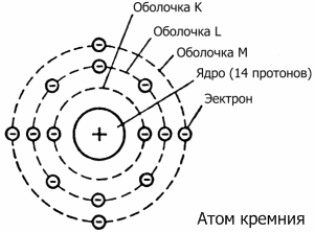
Figure 3
Latin letters in the figure indicate the shell. Depending on the number of electrons in an atom, their number can be different, but no more than seven: K = 2, L = 8, M = 18, N = 32, O = 50, P = 72, Q = 98. In each orbit, it can be a certain number of electrons. For example, on the last Q there are as many as 98, less is possible, no more. Actually, in terms of our story, this distribution can be ignored: we are only interested in electrons located in the outer orbit.
Of course, in fact, all electrons do not rotate in the same plane at all: even 2 electrons that are in an orbit with the name K rotate in spherical orbits located very close. And what can we say about orbits with higher levels! There it happens ... But for simplicity of reasoning, we assume that everything happens in one plane, as shown in Figure 3.
In this case, even the crystal lattice can be presented in a flat form, which will facilitate understanding of the material, although in fact it is much more complicated. The flat grid is shown in Figure 4.
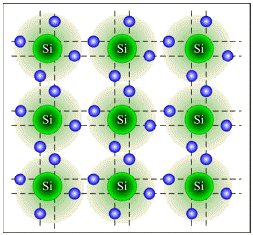
Figure 4
The electrons of the outer layer are called valence. It is they that are shown in the figure (the remaining electrons do not matter for our story).It is they who participate in the union of atoms into molecules, and when creating different substances, they determine their properties.
It is they who can break away from the atom and wander freely, and if there are some conditions, create an electric current. In addition, it is in the outer shells that the processes occur that result in transistors - semiconductor amplifying devices.
Continuation of the article: Transistors Part 2. Conductors, insulators and semiconductors.
Boris Aladyshkin
See also at bgv.electricianexp.com
:

